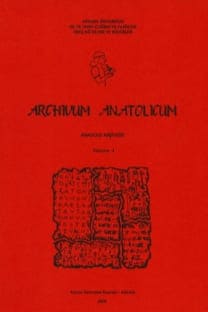ESKİ DOĞU AKDENİZ’DE BİR KRALİ LİMAN “AL-MİNA”
Öz
Hatay İli Asi
Deltası ve Samandağ Körfezi yakınlarındaki sahil şeridinde MÖ 8. yüzyılda aktif
olarak kullanıldığı düşünülen Al Mina Limanı 1936-1937 yılında gerçekleştirilen
kazılar sonucunda özellikle arkeolojik envanter açısından
değerlendirilebilmiştir. Yine bu coğrafyada gerçekleştirilen arkeolojik kazılar
limanın Geç Bronz Çağı’nda da ticarî faaliyetlerde kullanıldığı iddiasını
desteklemiştir. Buradan ele geçen arkeolojik bulgular arasında yer alan lüks
tüketime özel mallar ve ithal eşyalardaki çeşitlilik Al Mina’nın limanlar
arasında önemli bir ticaret ağının merkez istasyonu olabileceği yönünde
yorumlanmıştır. Al Mina’nın lokalizasyon
çalışmalarını olanaklı kılan kısıtlı filolojik belgeler, bölgenin Mitanni, Asur,
Babil ve Pers egemenliğinin ardından Hellenistik
Dönemde de belli zamanlarda işlevsel bir liman olarak kullanıldığını
belgelemiştir. Bu çalışmada, Anadolu, Batı Anadolu kıyıları, Mısır, Doğu
Akdeniz kent devletleri, Suriye ve kıta Yunanistan arasındaki ticarete ve
ticaretle gelişen kültürel etkileşime tanıklık etmiş Al Mina Limanı’nın yazılı
ve arkeolojik verilerle değerlendirilmesi amaçlanmıştır.
Anahtar Kelimeler:
Doğu Akdeniz, Al Mina, Levant
___
- Al-Maqdissi, Michel. “From Tell Sianu to Qatna: Common Features of Inland Syrian and Levantine Cities in the Second Millennium B.C. Material for the Study of the City in Syria”, Cultures in Contact: From Mesopotamia to the Mediterranean in the Second Millenium BC., edt. Joan Aruz, Sarah B. Graff, The Metropolitan Museum of Art, (2009).
- Aro, Jussi. “Remark on the Language of The Alalakh Texts”, AfO VII, (1954-1956).
- Astaour, Michael, C. “Place-Names from the Kingdom of Alalaḫ in the North Syrian List of Thutmose III: A Study in Historical Topography” Journal of Near Eastern Studies, Vol. 22, No. 4 (Oct., 1963).
- Astour, Michael C.- Fisher, L. R.,Smith, D. E.,Yamashita, T., “Ras Shamra Parallels: The Texts from Ugarit and the Hebrew Bible”, Analecta Orientalia III,(1975): 287-288.Boardman, John. “The Excavated History of al Mina”, Ancient Greeks West and East, (1999): 131-165.
- Dossin, Georges. Correâspondance de Samsi-Addu et de ses fils Archives Royales de Mari 1, Paris Imprimerie Nationale (1950).
- Dossin, Georges- A. Finet, Correspondence Feminine ARM 10, Geuthner, Paris (1946/1978).
- Downey, Glanville. Ancient Antioch, Prınceton Unıversıty Press, (1963).
- Elayi, Josette. Sargon II, King of Assyria, SBL Press, Atlanta (2017).
- Graham A. John. “The Historical Interpretation of Al Mina”, Dialogues D'histoire Ancienne, Année (1986): 51-64.Graham, A. John. Collected Papers on Greek Colonization, Brill Leiden, (2001).Grayson, Albert Kirk- Jamie R. Novotny. The Royal Inscriptions of Sennacherib, King of Assyria (704-681 BC), (RINAP 1) Eisenbrauns (2012).Hawkins J. David. “Hattin”, RIA 4, Berlin (1974): 160-162.Hawkins, J. David. “The Political Geography of North Syriaand South-East Anatolia in the Neo-Assyrian Period”, in M.Liverani (ed.)The Neo-Assyrian Geography, Roma (1995): 87-101.Hawkins, J. David. Corpus of Hiyeroglyphic Luwian Inscriptions; Vol. 1, Berlin (2000).Hawkins, J. David. “Cilicia, The Amuq, and Aleppo: New Light in A Dark Age”, Near Eastern Archaeology, Vol. 72, No. 4 (2009): 164-173.
- Heimpel, Wolfgang. Letters to the King of Mari: A New Translation, with Historical Introduction, Notes and Commentary, Eisenbrauns USA (2003).
- Kearsley, Rosalinde. “Greeks Overseas in The Eighth Century BC: Euboeans, Al Mina And Assyrian İmperialism”. Edt. G. Tsetskhladze, Ancient Greeks West and East Brill (1999): 109-132.
- Klengel, Horst. Syria, 3000 to 300 B.C.: A Handbook of Political History, Akademie Verlag, (1992).
- Lemaire, André. “Rechreches De Topographie Historique Sur Le Pays De Qué”, Anatolia Antiqua I, (1991): 270-279.
- Lehmann, Günnar. “Al Mina and The East”, A Report on Research in Progress . In: Alexandra Villing (Hrsg.): The Greeks in the East, London (2005): 1-32.
- Lipińsky, Edward. The Aramaeans: Their Ancient History, Culture, Religion, Peeters (2000).
- Miller, Jared. “Hititler Dönemi’nde Anadolu’da Halklar ve Diller”, Hititler: Bir Anadolu İmparatorluğu, Yapı Kredi Yayınları, İstanbul (2013): 120-127.
- Na’aman, Nadav. “Aribua and the Patina-Hamath Border”, Orientalia 71-Fasc. 3, (2002): 291-295.
- Na’aman, Nadav. “Ra’shu, Re’si-ṣuri, and the Ancient Names of Ras Ibn Hani”, BASOR, 334, (2004).
- Na'aman, Nadav. Canaan in the Second Millennium B.C.E., Eisenbrauns (2005).
- Naʼaman, Nadav. Ancient Israel and Its Neighbors: Interaction and Counteraction, Eisenbrauns (2005).
- Niehr, Herbert. Zaphon. Dictionary of Deities and Demons in the Bible, Leiden: Brill, (1999).
- Pamir, Hatice. Seleuceia Pieria, Ankara Üniversitesi Sosyal Bilimler Enstitüsü, Basılmamış Doktora Tezi, (2001).
- Pamir, Hatice. “Alalakh’dan Antiochei’ya Hatay’da Kentleşme Süreci”, Mustafa Kemal Üniversitesi Sosyal Bilimler Dergisi, Vol. 6-Sayı 1, Hatay (2009): 263-265.
- Pamir, Hatice. “Sabuniye: A Late Bronze-Iron Age Port Settlement on the Northeastern Mediterranean Coast”, Across The Border: Late Bronze-Iron Age Relations Between Syria and Anatolia-Proceedings of a Symposium Held at the Research Center of Anatolian Studies, Koç University, İstanbul-May 31-June 1 2010, (2013):173-194.
- Parker, Bradley. “The Mechanics of Empire. The Northern Frontier of Assyria A case Study in Imperial Dynamics”, Helsinki (2001).
- Parpola, Simo - Porter M, The Helsinki Atlas of the Near East in the Neo- Assyrian Period, The Neo-Assyrian Text Corpus Project, Helsinki (2001).
- Postgate, Nicholas. Fifty Neo-Assyrian Legal Documents, BIAA/Ankara. England 1(976).
- Schaeffer, Claude Frédéric-Armand. Ugaritica I-IV, Archive of Mesopotamian Archeological Site Raports (1939-1969).
- Smith, Sidney. The Statue of İdrimi, BIAA/Ankara, London, (1949).
- Soldt, Wilfred H. Van. “The Orontes Valley in Texts from Alalaḫ and Ugarit During the Late Bronze Age, 1500-1200 BC”, Syria, IV (2016): 137-144.
- Tadmor ,Hayim-Shigeo, Yamada. The Royal Inscriptions of Tiglath-Pileser III (744-727 BC) and Shalmaneser V (726-722 BC), Kings of Assyria, (The Royal Inscriptions of the Neo-Assyrian Period 1-RINAP 1) Winona Lake (2011).
- Wiseman, D. John. The Alalakh Tablets, BIAA/Ankara, London (1953).
- Woolley, Leonard. “The Excavations at Al Mina, Sueidia”, The Journal of Hellenic Studies, Vol.58/2 (1938): 133-170.
- Woolley, Leonard. “A Date of Al Mina”, The Journal of Hellenic Studies, Vol.68 (1948): 148.
- Woolley, Leonard. A Forgotten Kingdom, A Pelican Book, (1953).
- ISSN: 1300-6355
- Yayın Aralığı: Yılda 2 Sayı
- Başlangıç: 1995
- Yayıncı: Ankara Üniversitesi
Sayıdaki Diğer Makaleler
KÜLTEPE’DEN BAZI TİCARİ BELGELER VE BUNLARIN DEĞERLENDİRİLMESİ
KAYSERİ MÜZESİ’NDEN BİR GRUP KÜLTEPE TABLETİ
Koray TOPTAŞ, Mehmet Feridun YAVAŞ, İrfan ALBAYRAK
ESKİ DOĞU AKDENİZ’DE BİR KRALİ LİMAN “AL-MİNA”
LA(HU)WAZANTİYA: TİCARİ VE DİNİ BİR MERKEZİN TARİHÇESİ VE LOKALİZASYONU
